Have you tried the new DNA Compare on Ancestry? This feature, introduced in early 2023 , gives us even more insight to the ancestry we share with our friends and relatives.
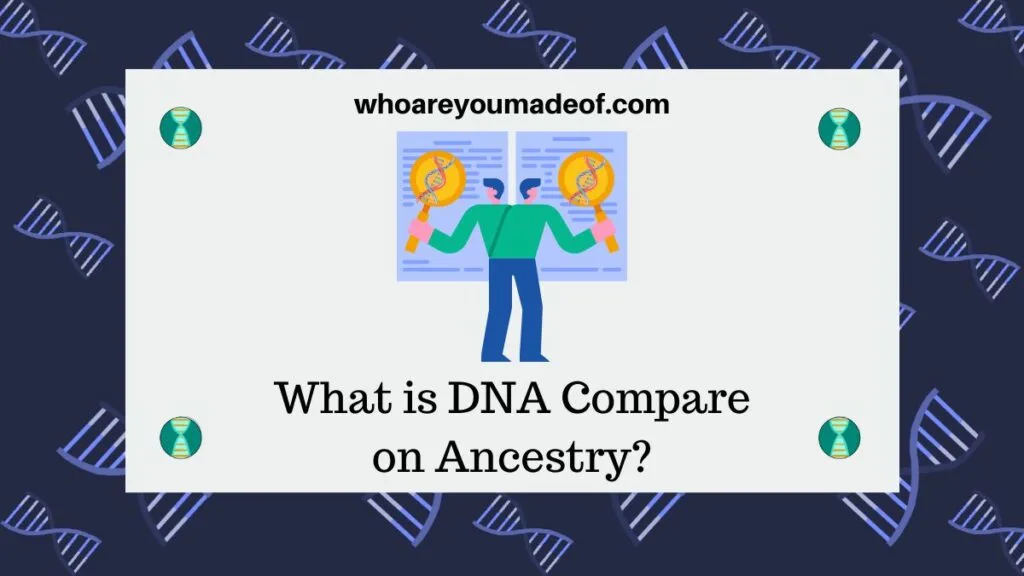
The DNA Compare feature is just one of the many new tools that Ancestry has added over the past year or so to help all of its DNA customers learn even more from their DNA results. Other tools that have been added and improved over the past several months include the DNA matches grouped By Parent and the Ethnicity Inheritance Sideview capability.
What is Compare My DNA on Ancestry
You will see the option to “Compare My DNA” on your Ancestry DNA Story page, directly under your Ethnicity Estimate. This feature lets you compare your DNA results with that of any of your DNA matches or anyone else who has shared their Ancestry DNA results with you.
DNA Compare is also a really great educational tool that will help everyone who has tested with Ancestry DNA to understand more about DNA inheritance.
Compare Ethnicity Regions
You will be able to see a side-by-side comparison between you and up to 10 DNA matches. The comparison will display all of the ethnicity regions that you and your matches have inherited from your ancestors.
In addition, you will also be able to see the DNA Communities that you and your selected matches have.
While we have always been able to see our DNA match’s ethnicity regions compared to ours, prior to this feature we could only view this one match at a time. Now, we can view many matches all on the same screen, which is very useful for comparing groups of cousins or siblings, for example.
Compare DNA Communities
We can also see DNA Communities that our matches belong to and compare between groups of matches. We can see these communities even if we don’t belong to the specific community ourselves if our DNA matches have permitted this to be shown on their results.
This tool saves a lot of time and provides useful visualizations.
How to compare your Ancestry results using DNA Compare
The DNA Compare feature is accessed from your main ethnicity estimate page. Below your ethnicity regions and DNA Communities, you will see a blue button that says “Compare my DNA”.
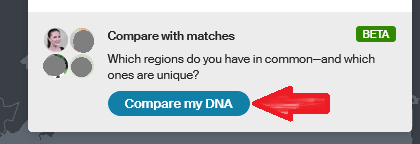
Remove and Add matches to DNA Comparison
When you first use the tool, the comparison will automatically be populated with your results as well as the results of your closest DNA matches. You can choose to remove these at an time by clicking on the three little dots next to your DNA match’s name, and then selecting the option to remove the match.
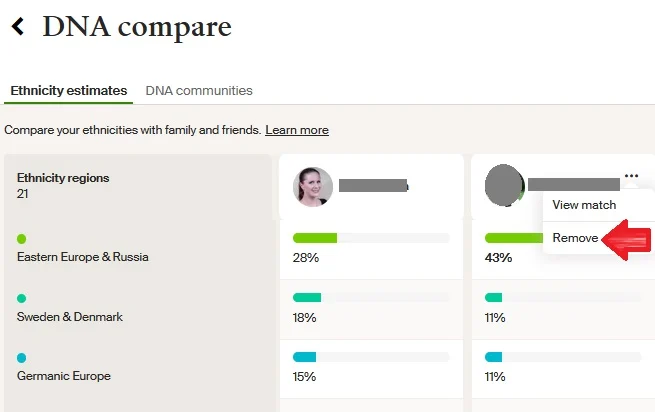
To add a new person to your DNA Compare page, you should click on the blue plus sign that says “Add someone”. A dialog box will appear and you can either enter the name of the person who you would like to add to the comparison, or select their name from the list of DNA matches and results that you manage.
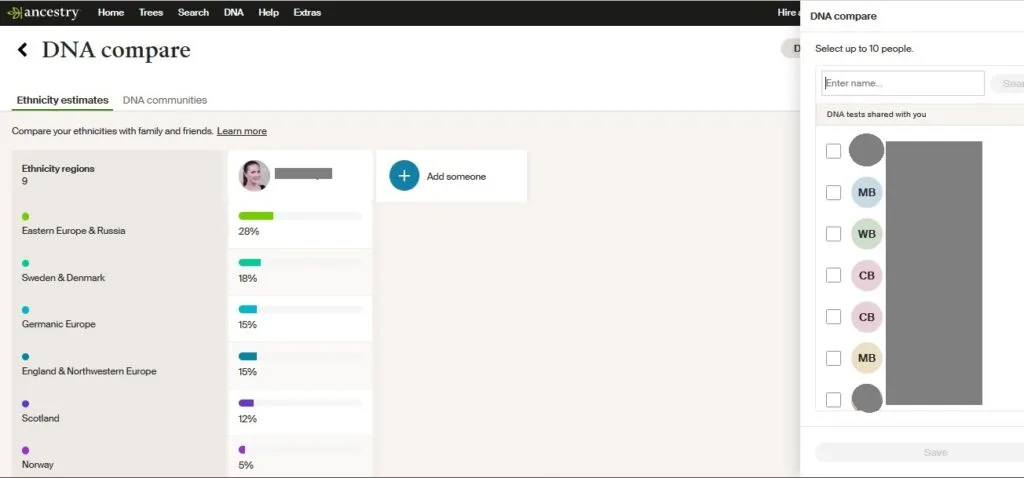
Who can you compare your DNA with?
You can use the new Ancestry DNA Comparison tool, also called DNA Compare, to make a comparison between your Ancestry ethnicity results and those of anyone who has taken an Ancestry DNA test. To compare your results with someone who is not a DNA match, they will need to share their DNA results with you.
Ancestry DNA customers who are DNA matches to you should show up when you search for them on the DNA Compare tool. If you want to compare your results with someone else who doesn’t match you, they will need to invite you to access their results via their Ancestry DNA test settings page.
DNA must be turned on in test settings
In order to use the DNA Compare tool, we should have DNA matches enabled on our results. Our genetic relatives on Ancestry must also allow matching on their results for us to compare our DNA results with theirs.
If you do not currently have DNA matching on your Ancestry results, navigate to the DNA test settings page and scroll down to the Visibility and sharing section. Then, click on the DNA matches arrow and set it to show matches.

What can you learn from DNA Compare on Ancestry?
DNA Compare can help give you ideas about how you might be related to a group of relatives. It can also help you spot patterns and learn more about your own results.
I have only just begun to explore DNA Compare to see exactly what I might be able to learn about my family by comparing our DNA results. One thing that I noticed immediately was how useful it was to compare my DNA Communities with those of both of my parents.
In the image below, I have shown my DNA Communities compared with both of my parents. I knew that both of my parents had some communities in the United States and I thought that some of them might have overlapped.
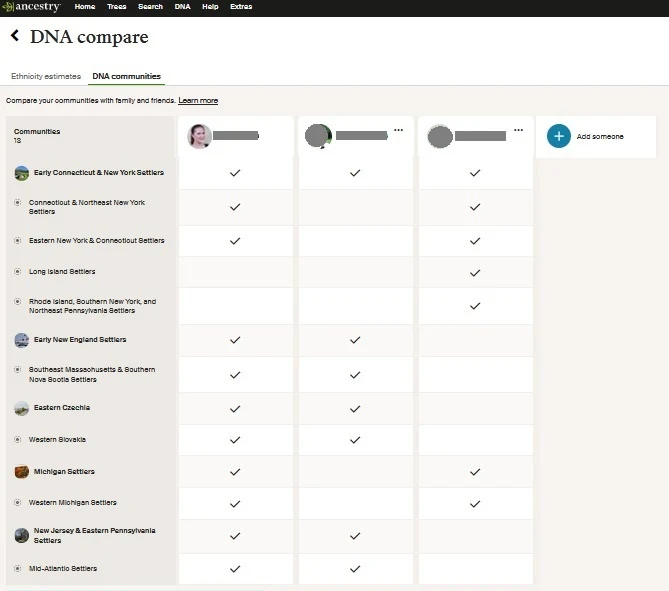
However, after looking at this very easy-to-understand comparison, I see that my parents don’t share any US DNA Communities in common at all. It was so much easier to make the comparison using this feature than switching back and forth between all three of our results.
Who knows what kind of observations you might make when you use this tool for your own comparisons?
Conclusion
I hope that this article has helped you understand how to access and use the DNA Compare tool on Ancestry. After you try it out, be sure to come back here and let me know something new that you learned about the regions and communities that you share, and don’t share, with your relatives.
Thanks for reading today!

D. Reeves
Tuesday 7th of March 2023
Thank you for explaining this new feature.